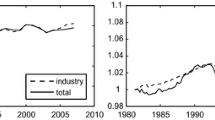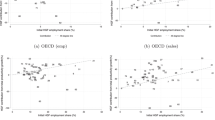Abstract
This paper studies the behaviour of hours-worked in the event of positive technology shock first in the closed economy DSGE model and second by adding a corporate profits in a bivariate SVAR model. Our analytical results show that in the presence of sticky prices, hours decrease in the event of a shock. However, in case of flexible prices or when central bank systematically respond to technology shocks, hours increase. Results based on SVAR model show that the inclusion of profits change the result of Gali (1999) by showing that hours increase at the aggregate level. However, sectoral analysis reveals different picture. Out of four only one sector is consistent with aggregate findings.











Similar content being viewed by others
Notes
The main findings of Kydland and Prescott (1982) papers are (i) investment is almost three times more volatile than output, (ii) nondurables consumption is less volatile than output, (iii) hours worked and output move in tandem, (iv) almost all macroeconomic variables are strongly procyclical (positively correlated with output), and (v) macroeconomic variables show persistency (Rebelo 2005, page 4).
The average duration of prices is 1/(1−η).
We define production function in level form as: \( {Y}_t={A}_t{N}_t^{1-\alpha } \) where Nt is number of hours worked and At measures technology.
Given k = (1 − α + αε)−1(v + α + σ(1 − α)) and by following Gali (2008) if set v = σ then we can show easily that k < 1 if and only if v > (2 − α)−1(1 + α(ε − 2)). Again following Gali, if we set α = 0.67, ε = 6 then we can show that k will be less than 1 if and only if v > 1.4 or wag elasticity (1/v) is great than 0.71.
Gali (1999) proposes to interpret permanent shocks to productivity as the technology shocks, which is consistent with many macroeconomic models.
Corporate Profits with Inventory Valuation Adjustment (IVA) and Capital Consumption Adjustment (CCAdj).
The Phillips-Perron unit root test also fails to reject unit root in the levels of all-time series, but rejects null for the first difference.
The Phillips-Perron unit root test for the sectoral data i.e. manufacturing, nonfinancial, retail trade and wholesales also fails to reject unit root in the levels of all-time series, but rejects the same null for the first difference.
Bureau of Labor Statistics
Source: BLS, the economic daily 2002
References
Ali S, Anwar S, Valadkhani A (2012) Macroeconomic consequences of increased productivity in less developed economies. Econ Model 29:621–631
Altig D, Christiano J, Eichenbaum M, Linde J (2011) Firm-specific capital, nominal rigidities and the business cycle. Rev Econ Dyn 14(2):225–247
Basu S, Fernald J, Kimball M (2006) Are technology improvements contractionary? Am Econ Rev 96(5):1418–1448
Benhabib J, Perli R, Sakellaris P (2006) Persistence of business cycles in multisector real business cycle models. International Journal of Economic Theory 2:181–197
Bjornland H, Leitemo K (2009) Identifying the interdependence between US monetary policy and the stock market. Journal of Monetary Economic 56(2):275–282
Calvo G (1983) Staggered prices in a utility maximizing framework. J Monet Econ 52:383–398
Chang Y, Hornstein A, Sarte D (2009) On the employment effects of productivity shocks: the role of inventories, demand elasticity, and sticky prices. J Monet Econ 56:328–343
Christiano J, Eichenbaum M, Vigfusson R (2003) What happens after a technology shock? NBER Working Paper 9819
Christiano J, Fitzgerald T (1998) The business cycle: It’s still a puzzle. Federal Reserve Bank of Chicago Economic Perspectives 22:56–83
Cooley F, Prescott E (1995) Economic growth and business cycles. In: Cooley TF (ed) Frontiers of business cycle research, pp. Princeton University Press, Princeton, pp 1–38
Dotsey M (1999) Structure from shocks. Working paper series. The Federal Reserve Bank of Richmond, pp 99–06
Francis N (2001) Sectoral technology shocks revisited. In: Unpublished manuscript; Bethlehem. Lehigh University, Pennsylvania
Francis N, Ramey V (2009) Measures of per capita hours and their implications for the technology-hours debate. J Money Credit Bank 41(6):1071–1097
Gali J (1999) Technology, employment, and the business cycle: do Technology shocks explain aggregate fluctuations? Am Econ Rev 89(1):249–271
Gali J (2008) Monetary policy, inflation, and the business cycle: an introduction to the new Keynesian framework and its application. Princeton University Press
Gali J, Lopez-Salido D, Valles J (2004) Technology shocks and monetary policy: assessing the Fed’s performance. J Monet Econ (50):723–743
Gali J, Rabanal P (2005) Technology shocks and aggregate fluctuations: how well does the real business cycle model fit the postwar U.S. data? In: Gertler M, Rogoff K (eds) NBER macroeconomics annual, vol 2004. MIT press, Cambridge, MA, pp 225–288
Hornstein, A. 2000. The Business Cycle and Industry Comovement. Federal Reserve Bank of Richmond Economic Quarterly Volume 86/1 Winter 2
Khan H, Tsoukalas J (2013) Effects of productivity shocks on hours-worked: UK evidence. The B.E. J Macroecon 13(1):1–31
Kiley, M., 1998. Labor Productivity in U.S. Manufacturing: Does Sectoral Comovement Reflect Technology Shocks? Mimeo
King, R., and Rebelo, S., 1999. Resuscitating real business cycles, in Handbook of macroeconomics, ed. by J. B. Taylor, and M. Woodford, chap. 14, 927–1007. Elsevier, Amsterdam
Kydland E, Prescott E (1982) Time to build and aggregate fluctuations. Econometrica 50(6):1345–1370
Long J, Plosser C (1983) Real business cycles. J Polit Econ 91:39–69
Lucas R (1997. Understanding Business Cycles) In: Brunner K, Meltzer AH (eds) Stabilization of the domestic and international economy. Carnegie-Rochester conference series on public policy, vol 5, pp 7–29
Prescott E (1986) Theory ahead of business-cycle measurement. Carn-Roch Conf Ser Public Policy 25:11–44
Rebelo, S., 2005. Real business cycle models: past, present, and future. NBER Working Paper 11401 http://www.nber.org/papers/w11401
Shea, J., 1998. What Do Technology Shocks Do? National Bureau of Economic Research Working Papers 6632
Taylor B (1999) The robustness and efficiency of monetary policy rules as guidelines for interest rate setting by the European central bank. J Monet Econ 43(3):655–679
Author information
Authors and Affiliations
Corresponding author
Additional information
Publisher’s note
Springer Nature remains neutral with regard to jurisdictional claims in published maps and institutional affiliations.
Rights and permissions
About this article
Cite this article
Malik, K.Z., Ali, S.Z. Is the empirical relationship between hours and productivity effected by corporate profits?. J Econ Finan 44, 99–119 (2020). https://doi.org/10.1007/s12197-019-09477-5
Published:
Issue Date:
DOI: https://doi.org/10.1007/s12197-019-09477-5




